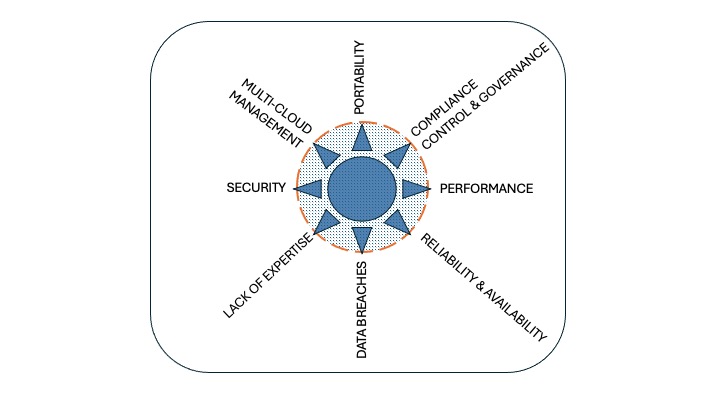
Many organizations still operate without a defined cloud strategy or even a cloud skills plan to follow. This, among others, poses challenges to the users who wish to take the best advantages of the newest emerging trends of cloud and multi-cloud services.
According to Pluralsight, as much as 70% of organizations struggle to drive “customer value” in the cloud. Of those 70%, more than 50% say they have half or more of their infrastructure in the cloud. And ironically, another 49% say they are “actively moving more of their data” into the cloud.
The question becomes, without the needed resources that are essential to keeping the wheels on the bus going round and round, how long will it be before a potential head on collision with cloud and business be expected? And what can, should or must we be doing to cut the potential risk down?
Cloud maturity is a hypothesis that takes the steps of implementing the “mechanics” of cloud and moves it to a more focused, lean and effective methodology of making the cloud work without overtaxing the team or the budget."
This isn’t any longer about “migration” (to the cloud), it’s about the “rapid acceleration of and the adoption of many new services” that depend on and leverage the cloud. But a surprising percentage of these leaders don’t have a strategy, plan or approach on how to achieve these targets.
Moving From Tactical to Strategic
Cloud maturity is a hypothesis that takes the steps of implementing the “mechanics” of cloud and moves it to a more focused, lean and effective methodology of making the cloud work without overtaxing the team or the budget. Using an “ad hoc” tactical approach may resolve short-term issues, but it is by no means a methodology for the long term.
In some circumstances, leaders have become so focused on the technology of the tactical approach that they forgot to see the forest for the trees. Prioritization was lost, structure was fragile, and the outcomes were meniscal if any.
Culturalism
Your organization is likely very good at what it does, but sees and hears about the cloud, about AI, about machine learning (ML) and yet can’t see how or why it might be advantageous for the team—likely because no one on the team knows about those terms or how they might fit into their own structure or day-to-day life.
Well, my friends, get ready for a change because those previous three terms (AI, ML and cloud) are well-integrated into this new world and are making huge inroads into the next generation of tactics, strategies and operations right now (not next year or the next quarter, but right now!).
One of the first steps in approaching cloud maturity is to change/shift the culture in the organization. Many (around two-thirds) of these organizations put an emphasis on technical training of their teams, ignoring the elements associated around “cloud native” learning company-wide.
Cloud is a culture with its own language, its own “speak,” its own management, and its own sales approach. Perhaps this is why the whole concept of artificial intelligence is so challenging. The public is asking our government to place limits on things that even they (the rule makers) don’t live, breath or speak about daily. This has got to change, starting on the ground floor.
Cloud Literacy
According to findings used in the research of this article, only about 15% of most organizations’ team members understand or know much about cloud terminology. However, more than 40+% of the IT team members of those organizations surveyed have a sufficient technical understanding of cloud to aid in supporting a transition to the “new world.” A surprising amount of the IT staff and leadership staff possess a high degree of cloud understanding, with almost 75% of the IT staff being either cloud-certified or are learning cloud.
This puts the burden clearly on the educator’s communities and in getting everyone up to speed, just like learning reading, writing and arithmetic. This is priority one!

Policies, Tactics and Issues
Last year (2023) security was described as the one area that continually needs to be improved upon. It was listed as “the number one challenge” and the area with “the largest skills gap.” Most searches on cloud needs will start with security being the top issue. The other positions cloud users and administrators should look to include (see Fig. 1):
-
Compliance: ISO 27001 is the international gold standard for information security management. It proves the strength of your security posture to prospects and customers in global markets. Achieving ISO 27001 certification can be time-consuming and expensive.
-
Performance:
Cloud performance tuning is the process of optimizing the speed, efficiency and reliability of cloud-based applications and services. It requires a combination of technical skills, analytical tools and best practices to identify and resolve bottlenecks, errors and resource wastage.
-
Reliability and Availability:
Availability in cloud computing is a crucial aspect of reliability, focusing on the accessibility of services to users. It indicates the percentage of time that a cloud service is operational and reachable.
-
Data Breaches:
Are numerous, avoidable and can be mitigated by following suggested practices in this and other documents related to security and best practices. The largest (top) in the amount of exposed data was the Indian Council of Medical Research (ICMR) in October 2023, where a threat actor using the alias “pwn0001” posted a thread on Breach Forums brokering access to identification and passport details (including names, addresses and phone numbers) of 81.5 million citizens of India.
-
Lack of Expertise:
Covered in part in this article, the cloud and IT skills shortage is apparently damaging organizational landscapes and is expected to impact businesses in critical areas such as not meeting financial targets, increased exposure to security risks and digital transformation delays.
-
Security:
Four top areas of concern include (1) Unmanaged Attack Surface; (2) Human Error; (3) Misconfiguration; (4) and Data Breach.
-
Multiple Cloud Management:
A set of tools and procedures that allows a business to monitor and secure applications and workloads across multiple public clouds. Ideally, a multi-cloud management solution allows IT teams to manage multiple clouds from a single interface and supports multiple cloud platforms (such as AWS and Azure) as well as new tools like Kubernetes.
-
Portability:
Portability and interoperability relate to the ability to build systems from re-usable components that will work together “out of the box.” A particular concern for cloud computing is cloud onboarding—the deployment or migration of systems to a cloud service or set of cloud services.
-
Control and Governance:
Is a set of rules and policies adopted by companies that run services in the cloud. The goal of cloud governance is to enhance data security, manage risk and enable the smooth operation of cloud systems.
As one can tell, cloud management tools for success are not unlike those found in many IT administration practices. The topics are broad, and the tool sets available from service providers are vast. The best advice this can provide will be to ensure the organization has a structure and an aligned forum inside the leadership to start today on a foundation and a plan to be ready for the “now” in cloud. Seek a consultant or a professional who understands the prospects, needs and has the capabilities to drive forward the cloud maturity needs for the entire organization. l
Karl Paulsen is the retired CTO from One Diversified LLC. He has 50 some years of experience in broadcast media technologies and is a regular contributor to TV Tech in the fields of cloud, media, IP and AI. Look for an upcoming series on AI over the coming months. He can be reached at karl@ivideoserver.tv.







